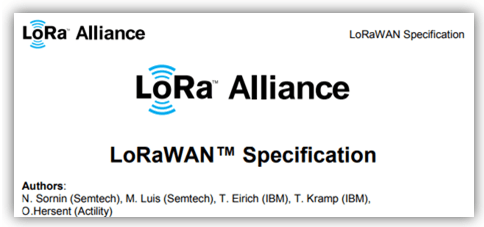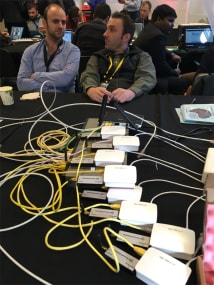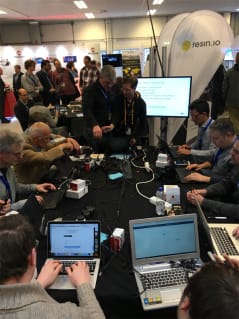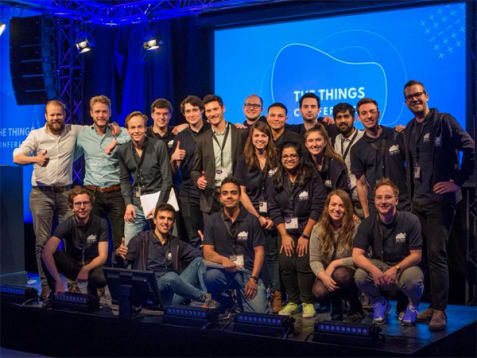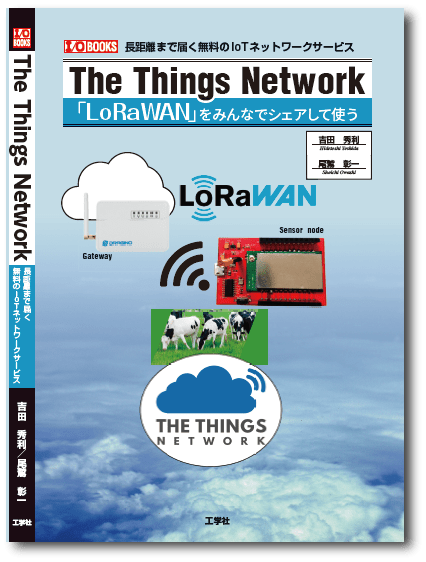Report on The Things Conference
Follow articleHow do you feel about this article? Help us to provide better content for you.
Thank you! Your feedback has been received.
There was a problem submitting your feedback, please try again later.
What do you think of this article?
Another author listed here is Thorsten Kramp (IBM). A researcher at IBM's facility in Zurich, Switzerland, Dr Kramp developed and open-sourced LMiC (LoRa Mac in C), an Arduino shield for using LoRa on Arduino devices. He also created the IBM LRSC (Long Range Signalling and Control) MQTT expansion. This technology was later adopted by advanced firms such as network carrier KPN for business use. It was also adopted by the Netherlands, now a famous world-leader in LoRaWAN infrastructure, and home to The Things Network (TTN) and a grassroots LoRaWAN community. If it was not for the forward-thinking teamwork from these two developers, it is likely that LoRa would never have experienced the same level of popularity. Being able to see one of them speak in person filled me with excitement for the event.
The Things Conference took place in Amsterdam in early February, to a backdrop of cloudy weather with occasional rain and sleet as the temperature dropped. The headquarters for The Things Network's has recently been relocated from the city centre to a redeveloped business-centre area, approximately 25 minutes from Amsterdam Centraal station on foot. The city is home to a vast amount of bicycle commuters and dedicated bike paths can be found all over the city (left).
The Things Conference took place at the Rockstart headquarters, a venture capital firm that has invested in over 60 startup companies listed in European markets. Before the opening ceremony on the first day, all the screens in the event area were showing the sales video below.
An admission fee was charged for seminars at this year's Things Conference, requiring you to a purchase a ticket for €349, €499 or €799. Three iPads at the entrance allowed visitors to check their pre-registration data and enter the conference. When going in, the "Wall of Fame" below was on display, showing assorted LoRa-related products.
One of the items on the wall was a Geiger counter monitor, developed by Safecast Japan. More of Safecast's LoRa-compatible environment monitors were displayed on a dedicated shelf. Safecast representative director Pieter Franken hosted a keynote speech on the second day of the conference.
* Safecast's LoRa module-compatible environmental monitoring sensors
https://safecast.jp/
The room where the keynote speech took place on 1 February, the first day of the event, was full.
The room can seat up to around 500 people and there were still others standing. I was not able to get inside to see the main stage, so I watched the events on a screen in an adjacent sub-room (I should have arrived earlier but I did not think that it would be so crowded).
The sub-room was just as crowded and I recorded the feed on my iPad from the back row.
The opening session began with a speech from TTN CEO Wienke Geizeman, who received a huge round of applause. This was followed by the keynote speech from Nicolas Sornin, the inventor of LoRa wireless modulation technology. Many of the attendees were LoRaWAN experts and Sornin is something of a celebrity among them. The moment he began to speak, everyone fell quiet and there was a sense of anticipation swept through the room.
I, too, was curious about what Sornin thought about LoRa's future, so being able to see this keynote speech was incredibly useful to me.
* A bird-shaped environmental monitor designed with STMicroelectronics' STM32 LoRa development module and a 3D printer
3.Microchip
Semtech has licensed LoRa wireless technology to two firms: STMicroelectronics and Microchip, whose RN2483 wireless chip features LoRa wireless tech and a MCU.
At Microchip's workshop table, visitors used soldering irons and received training on how to design an RN2483 circuit board and develop their own nodes.
* Microchip displayed their products on a large lounge table
4.resin.io
Resin.io's workshop table gave visitors detailed information on how to build IoT services using the RAK831 multi-channel gateway module for Raspberry Pi (made by China's RAK Wireless) and their own IoT platform. The services resemble the Cayenne tool for visualising sensor data, provided by Semtech subsidiary myDevices.com.
* Raspberry Pis and LoRaWAN gateway kits from RAK Wireless were used by resin.io
http://www.rakwireless.com/en/WisKeyOSH/RAK831
5.Amazon
Amazon's AWS team was also sponsoring a workshop table at this year's event, perhaps because TTN has expanded native support for AWS. Using several Things Nodes, the LoRa sensor nodes developed by TTN, they offered training on building AWS IoT platforms.
* TTN's Things Node, a LoRa sensor module (sadly, this has not yet acquired technical standards compliance)
https://uk.rs-online.com/web/p/sensor-development-kits/1359784/
6.myDevices.com
myDevices.com, purchased by Semtech last year, provides a visualisation platform known as Cayenne for LoRa sensor data. Cayenne is ideal for normalising sensor data, and its LPP (Low Power Payload) provides support for the IPSO Alliance's Smart Objects international standard.
https://mydevices.com/cayenne/docs/lora/#lora-cayenne-low-power-payload
Cayenne is both highly compatible with TTN and available for free.
* LoRa nodes and LoRaWAN providers supported by Cayenne
7. The Things Network Vienna community
Although it was not on the agenda for the first day, this workshop table was home to a presentation by Stefan Schultheis from The Things Network Vienna. He talked about LoRa GPS tracking and mapping and using an Arduino LoRa GPS shield developed by Edwin Chen, CEO of the Chinese company Dragino and a personal friend of mine for ten years.
* Dragino's Arduino LoRa GPS shield. This device does not have technical standards approval in Japan. Instead, Japanese firm OpenWave has obtained approval for the LoRa mini, a more compact LoRa device equipped with an ATMega328, and the LG01-JP compact LoRaWAN gateway.
http://www.openwave.co.jp/lorawan/
* The device works well with the TTN Mapper, available for free to anyone with a TTN account. https://ttnmapper.org/
8.Junior IoT Challenge
The final day fell on Saturday 3 February, allowing children from local elementary schools in Amsterdam to develop LoRa nodes independently at the workshop table. There are too many LoRaWAN gateways around Amsterdam to count, making it easy to launch TTN nodes. I saw the children at the table using the Arduino IDE and adjusting their LoRa wireless diffusion rates, and it made me think about the literacy gap Japan has in its LoRaWAN network environment.
* A vast amount of TTN gateways are available for use across Amsterdam, allowing anyone to easily access LoRa sensor nodes
9.Notable TTN communities worldwide
The third and final day featured discussions that focused on communities. One of them was a roundtable featuring famous initiators (the term for TTN community leaders) for groups with over 100 members. They included, from the left:
- Loma Goulden from TTN Eindhoven
- Mirko Ross from TTN Stuttgart
- Terry Moore from TTN NYC (New York)
- Mark Stanley from TTN Reading
- Claire Garside from TTN Hull
10.TTN core staff
CEO Wienke Geizeman is on the far left of the back row. Next to him is tech lead (CTO) Johan Stokking.
Finally, the release date for the new Things Network (TTN) book I've been working on with Kogakusha since late last year has been set for 9 February. Why not take this opportunity to share LoRaWAN with everyone around you?



